Gr11 Math
1/80
There's no tags or description
Looks like no tags are added yet.
Name | Mastery | Learn | Test | Matching | Spaced |
|---|
No study sessions yet.
81 Terms
Unit 1
Intro to Functions
Relation
A rule that associates an x-value with y-value(s)
Function
A special type of a relation in which there is only one value of dependent variable (y-value) for each value of the independent variable (x-values)
Meaning in a function when you plug in x you will only get one y value
Vertical Line Test
If any vertical line passes through more than one point on the graph, the relation is not a function
Domain
The set of possible values of the independent variable (x)
Ex. D={x∈R |0<x<5}
Range
The set of all possible values of the dependent variable (y)
Ex. R={y∈R |0<y<5}
Function Notation
f(x) = y
Sub in what is in the brackets to find f(x)
To find f(x) given another equation:
Asymptote
A line that the graph of a relation hets closer and closer to, but never meets
Axis of symmetry
When a vertical line can split a function evenly at a certain x coordinate
Quadratic Function (Parent Function)
f(x) = x²
AOS: x=0
D={x∈R}
R={y∈R|y=>0|}
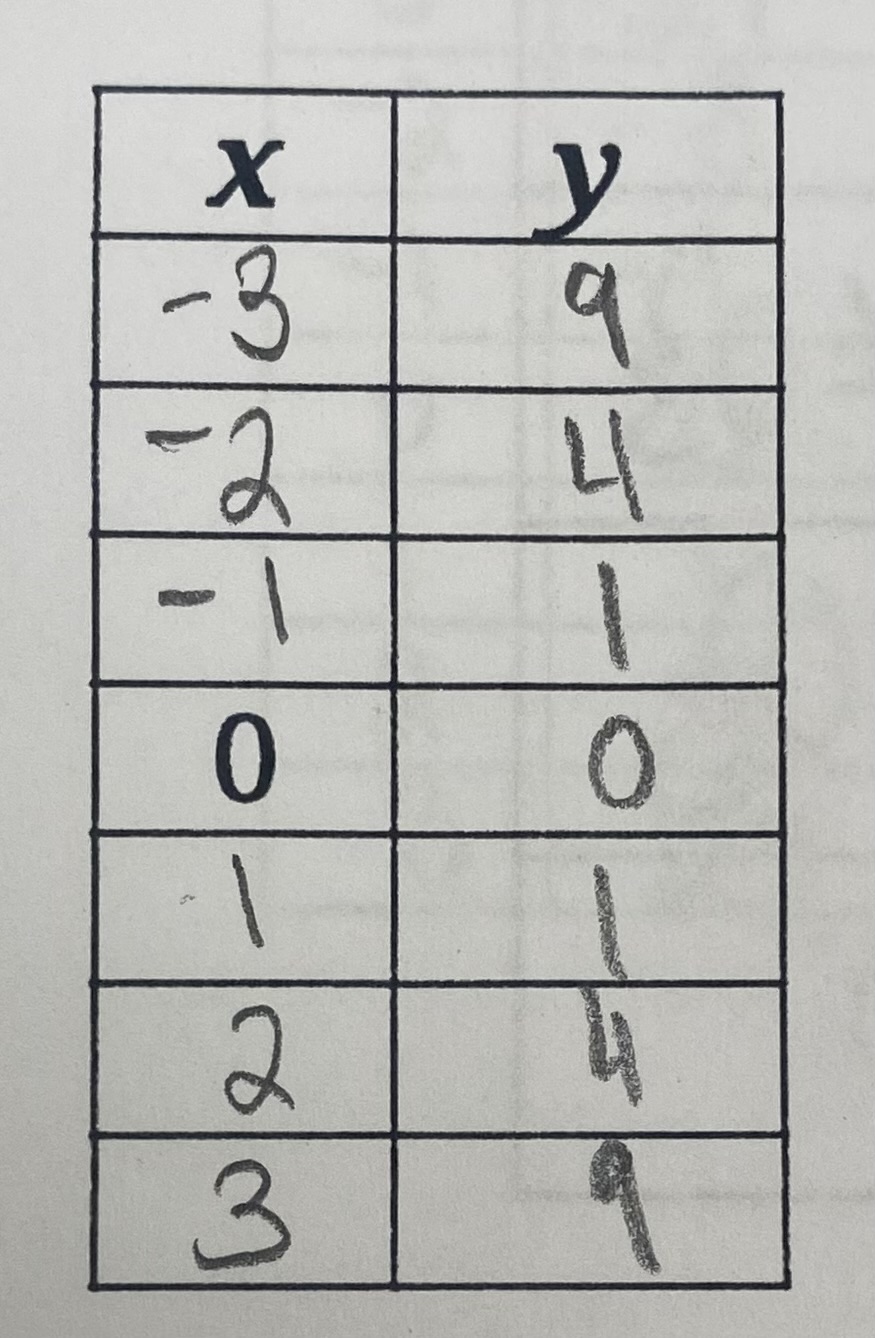
Square Root Function (Parent Function)
f(x) = √x
D={x∈R|x=>0|}
R={y∈R}
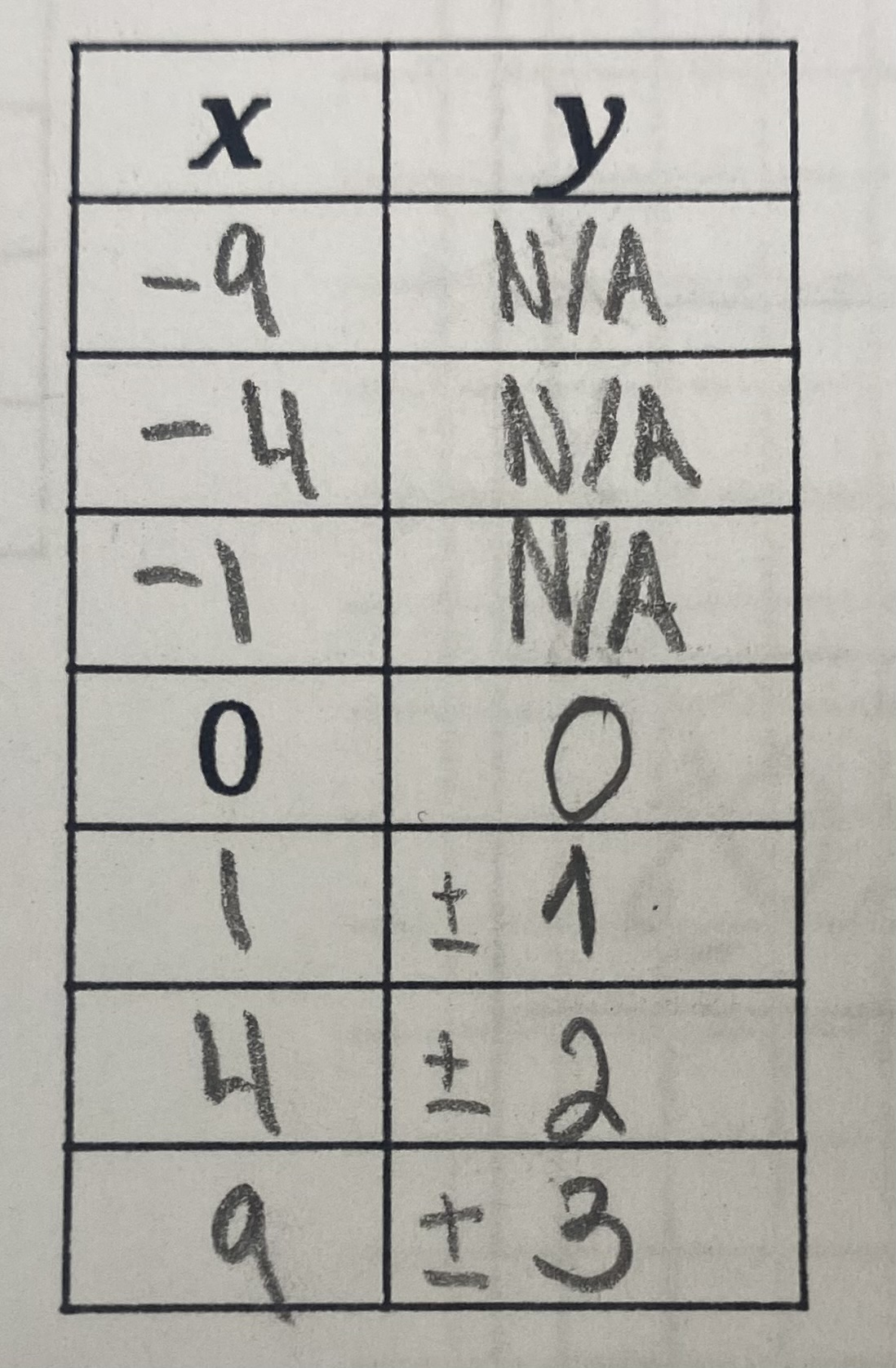
Reciprocal Function (Parent Function)
f(x) = 1/x
D={x∈R|x≠0}
R={y∈R|y≠0}
Asymptotes: y=0, x=0

Absolute Value Function (Parent Function)
f(x) = |x|
D={x∈R}
R={y∈R|y=>0|}
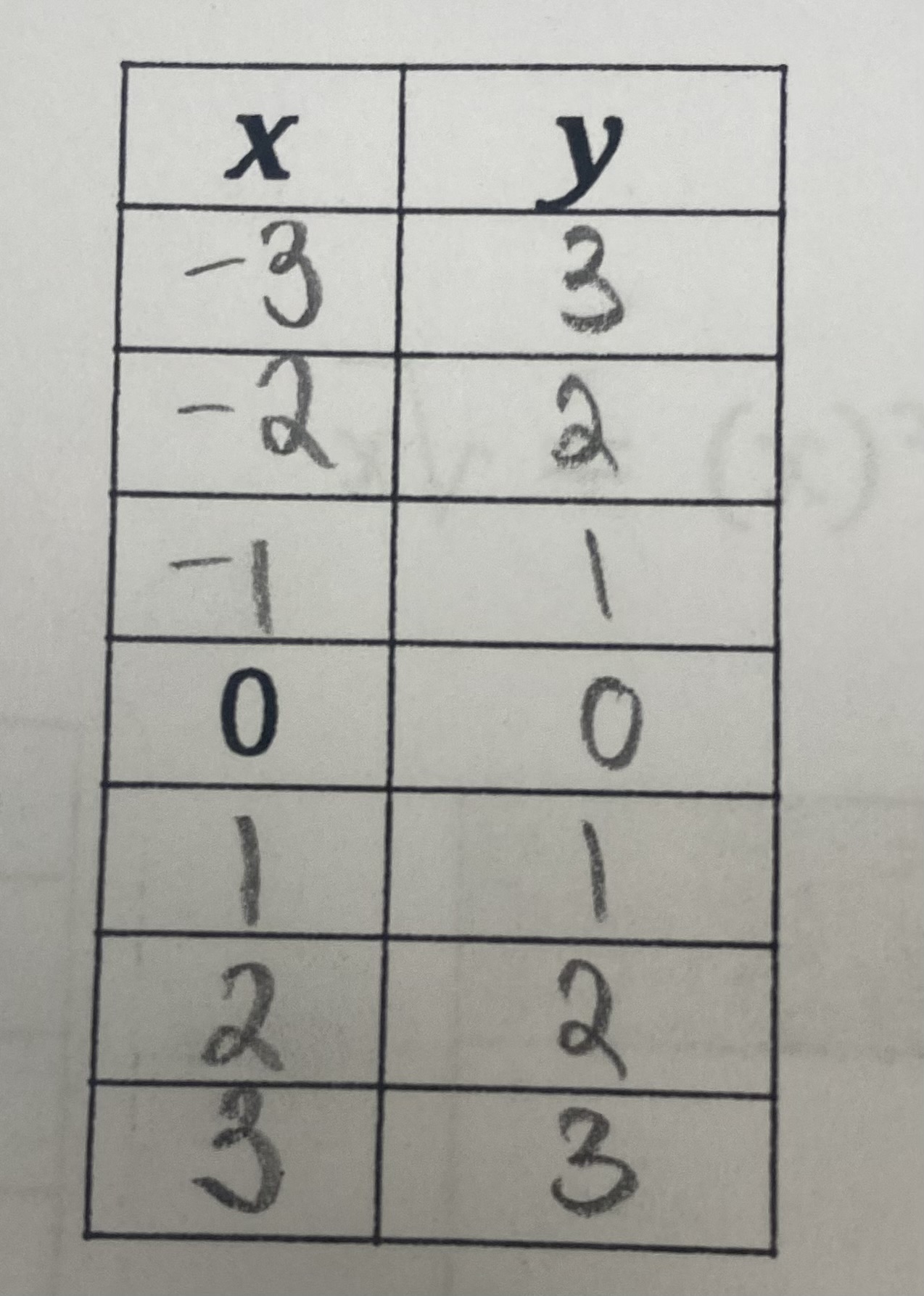
Cubic Function (Parent Function)
f(x) = x³
D={x∈R}
R={y∈R}

Vertical Transformation
c
y= x² + c
When c > 0, the parabola shifts vertically c units up
When c < 0, the parabola shifts vertically c units down
Horizontal Transformation
d
y= (x-d)²
When you use d switch its sign
When d > 0, the parabola shifts horizontally d units right
When d < 0, the parabola shifts horizontally d units left
Vertical Stretches/Compressions
a
y= a√x
When a is negative, the function is reflected in the x-axis
When |a|>1 the function is vertically stretched
When 0<|a|<1 the function is vertically compressed
Horizontal Stretches/Compressions
k
y= √kx
Put k over 1 when finding compression or stretch
When k is negative, the function is reflected in the y-axis
|k| > 1 the function is horizontally stretched bafo 1/k
0<|k|<1 the function is horizontally compressed bafo 1/k
Summary of transformations
Switch the k and d values for when you put them in this equation

Equation of a transformed function
f(x) = a f (k(x-d)) + c
How to get inverse functions form the coordinates and algebraically
From coordinates just swap x and y
From expression switch places of x and y and solve for y
Remember that if you restrict ur inverse to make it a function, you have to restrict your original
Unit 2
Algebraic Expressions and Factoring
Polynomial
Expression with one or more terms
Factoring by grouping
Usually you will have 4 terms which you can split into 2 groups
Factor the GCF from those 2 terms
If you get a common term in the brackets then you did it right
Finally write two brackets one with the common term and the other with the 2 things you factored out
Factoring trinomials where the leading coefficient is 1
Factor out a GCF if there is one
Find two numbers that add up to get the b term and multiply to get the c term
Write the two numbers in brackets like this:
(x + n1) (x + n2)
Factoring trinomials where the leading coefficient is not 1
Multiply the coefficient of the a term by the c term
Find 2 numbers that multiply to give you the new number and add to give you the b term
Replace the b term with those 2 numbers
Factor by grouping
Factoring a perfect square trinomial
Equation: A² + 2AB + B² = (A + B)²
Square root the a and c terms and then multiply them
Multiply that answer by 2 if you get the b term you can use the formula
Take the square root of the a and c terms then write it like this: (2x + 4)²
Factoring a difference of squares
Equation: A² - B² = (A + B) (A - B)
Make sure you can take the square root of both terms and that it is a minus they cant be added
Square root both terms and put them in 2 brackets one with a plus and the other with a minus
Note: Sometimes you can do this after taking out the GCF so after you take it out just leave it infront of the first bracket
Multiplying Rational Expressions
Steps:
Factor
Restrict
Multiply (use brackets)
Simplify (cancel)
Dividing Rational Expressions
Steps:
Factor
Restrict
Keep Change Flip
Restrict
Multiply
Simplify
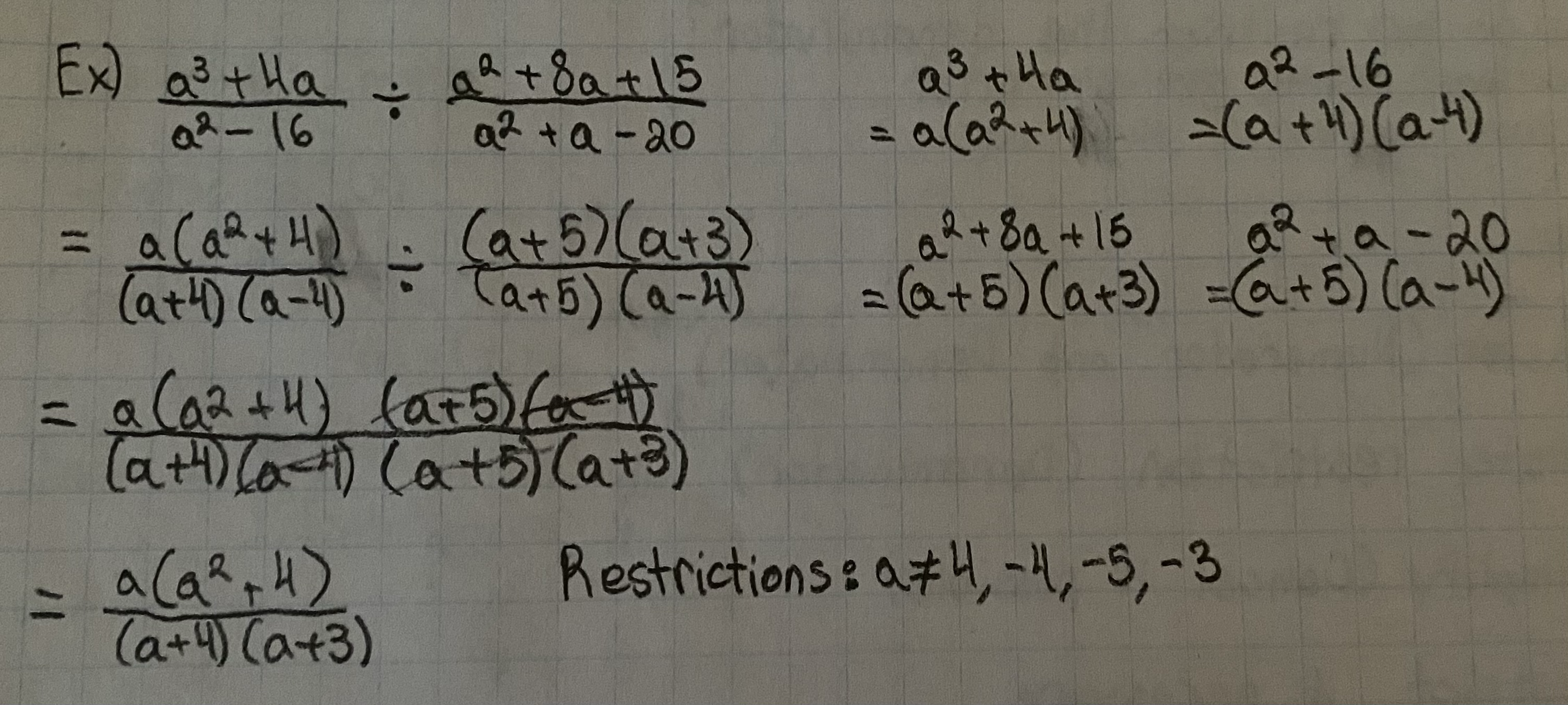
Adding/Subtracting Rational Expressions
Steps:
Factor
Restrict
LCD
Expand (Numerator only)
Simplify (Factor and Cancel)
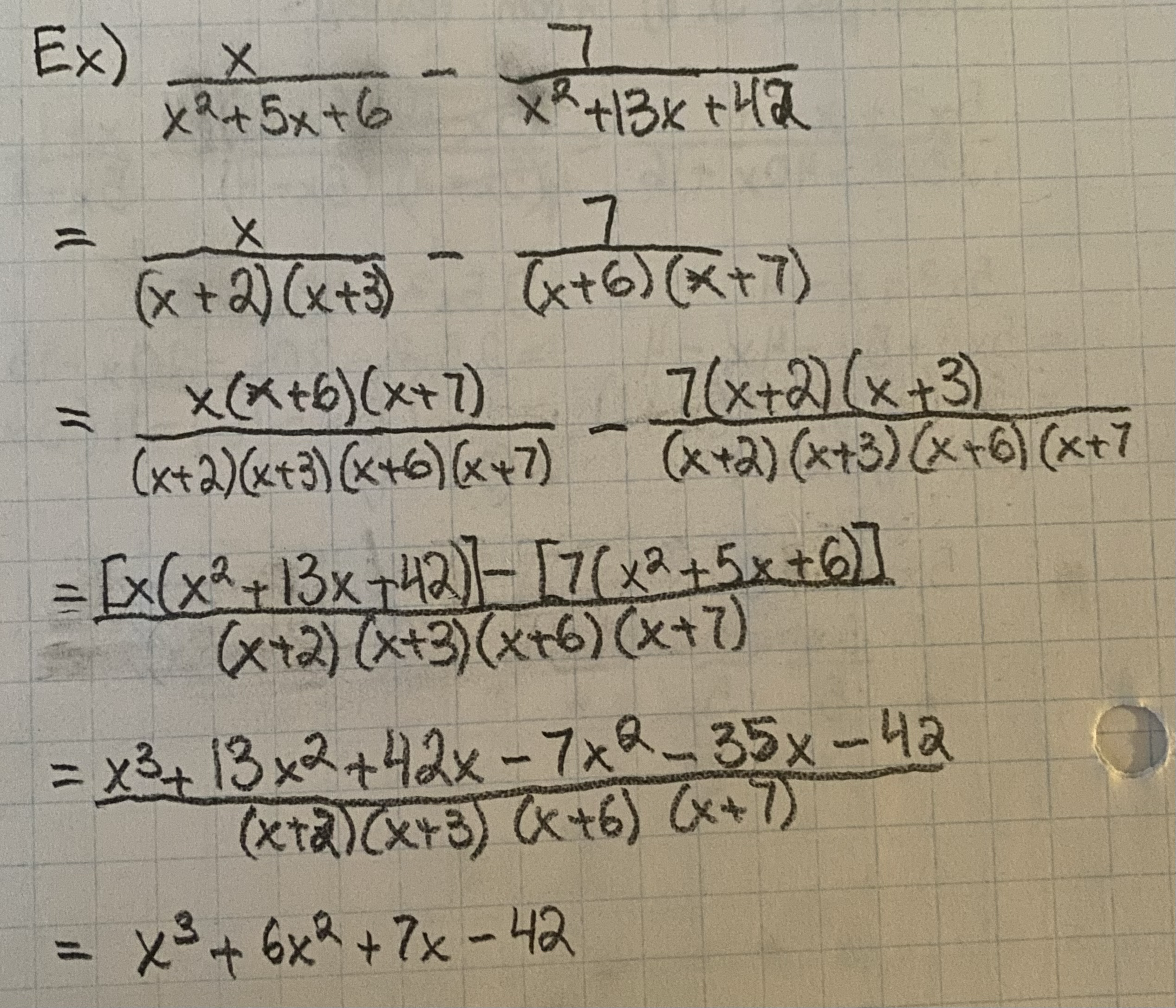
Unit 3
Quadratic Functions
Graphing a quadratic
Quadratic functions are a parabola
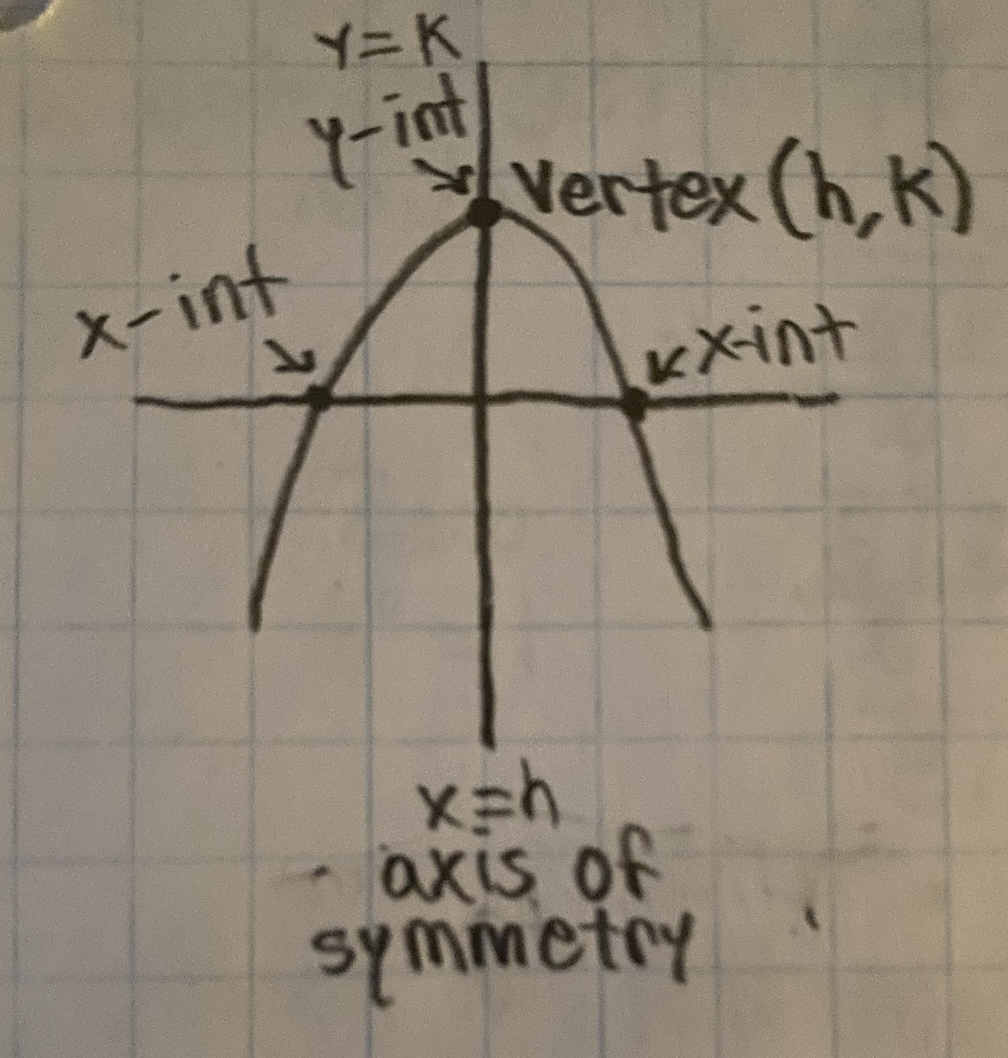
Three forms of Quadratic Equations
Standard Form
= ax² + bx + c
a: Direction of Opening
c: y- intercept
Factored form
= a(x-s)(x-t)
s: x-int
t: x-int
Vertex Form
= a(x-h)² + k
h: x-value of vertex
k: y-value of vertex
How to solve a quadratic equation
To solve a quadratic equation means to solve for x meaning you are looking for the x-intercepts or roots
The 3 ways of solving are:
Quadratic Formula
Factoring
Isolating for x (if its in vertex form)
How to find the vertex of a parabola
If the equation is in standard for you can find the x-value of the vertex using h = -b/2a
Then you can plug in h into the equation to find the y-value of the vertex
Parts of a Radical and Radical types
Index: The number that it is being rooted by usually a small number left of the radical symbol
Radicand: The expression under the radical sign
Entire Radical: √10 (has coefficient of 1)
Mixed Radical: 3√5 (has coefficient other than 1)
Laws of Radicals (Multiplication and Division)
Multiplication: First multiply Coefficients with Coefficients and Radicals with Radicals, then reduce if there is a radical that can be reduced
6√20 → 12√5
Division: Reduce by making sure there is no radical on the bottom, this can be done by reducing and multiplying both sides
Adding/Subtracting Radicals
Simplify radicals into mixed radicals and collect like terms
Rationalizing the Denominator
This means to make the denominator not have any radicals
Sometimes this can be done by multiplying by the conjugate
Conjugate: binomial with opposite sign in the between the 2 terms
Solving Linear-Quadratic Systems
Means to find the point(s) of intersection of a linear and quadratic equation
Steps:
Make equations equal to each other
Make equation equal to 0 to solve
Plug in solutions into original equations to find y-values
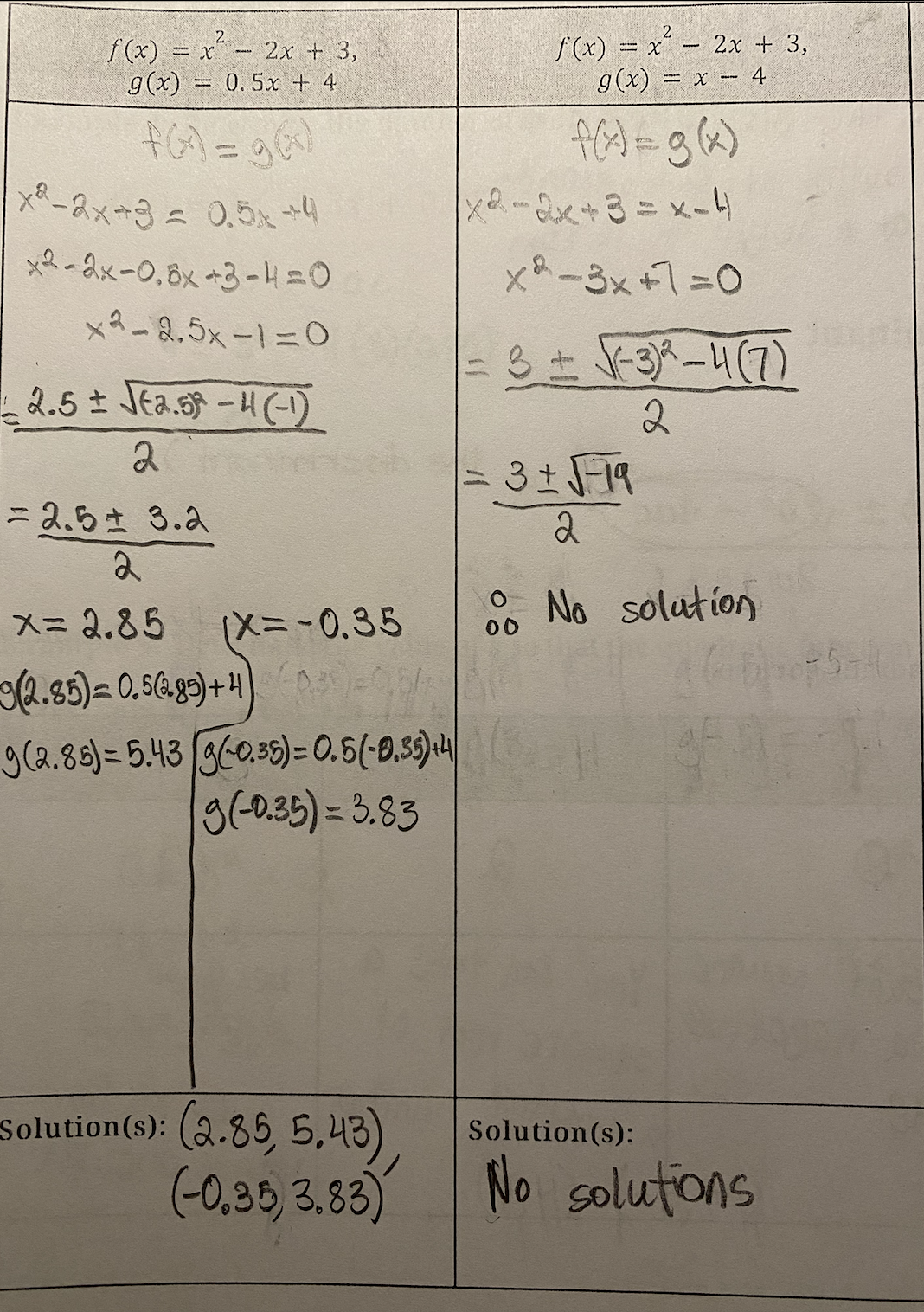
Unit 4
Exponential Functions
Exponent Laws (multiplication, division, quotient, power, product, zero, negative)

What is a rational exponent
Something to the power of a fraction

Equation of Exponential functions
f(x) = a(b)^x
Growth: b > 1
Decay: b < 1
*b is always positive
Properties of a Exponential function
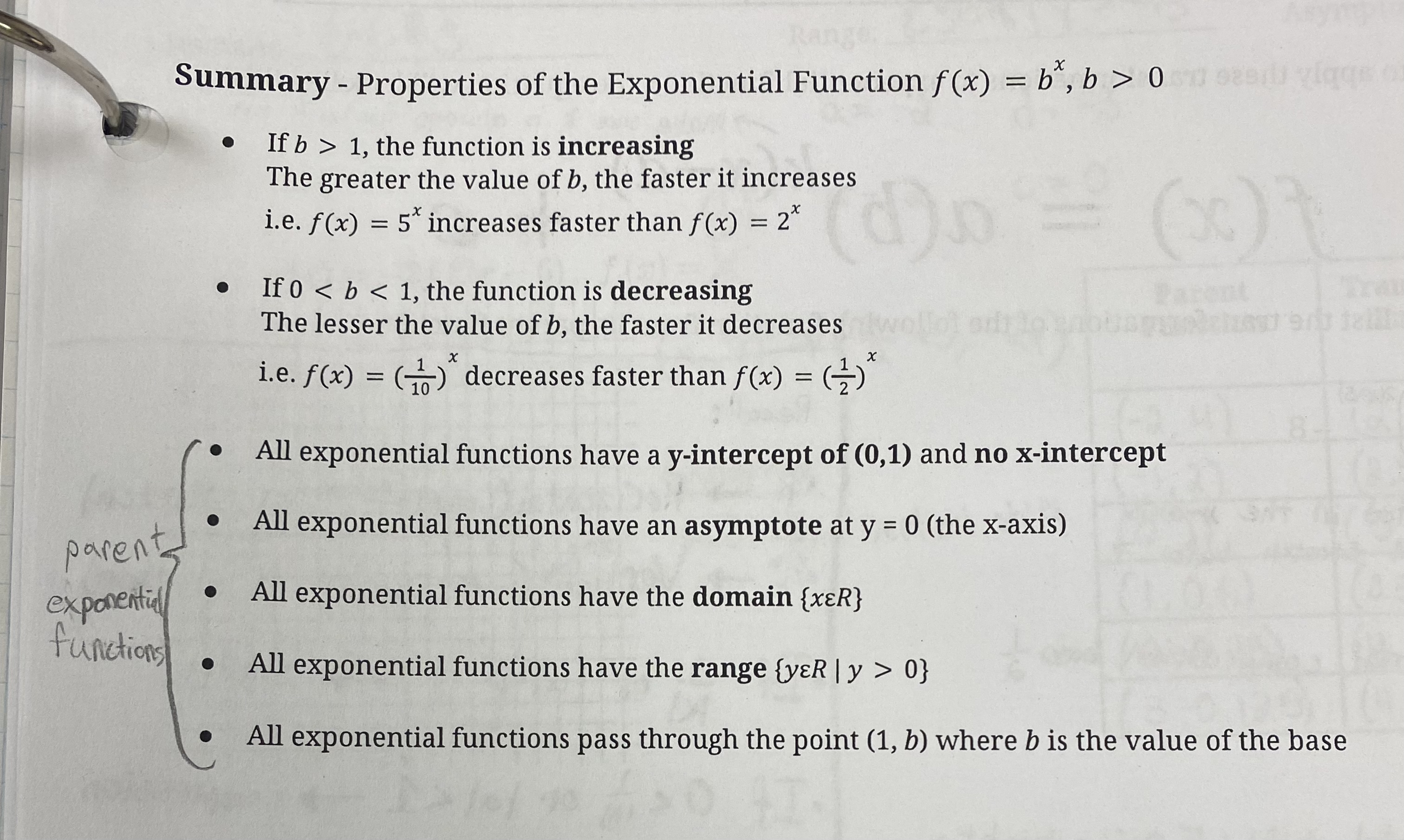
Transforming an Exponential function
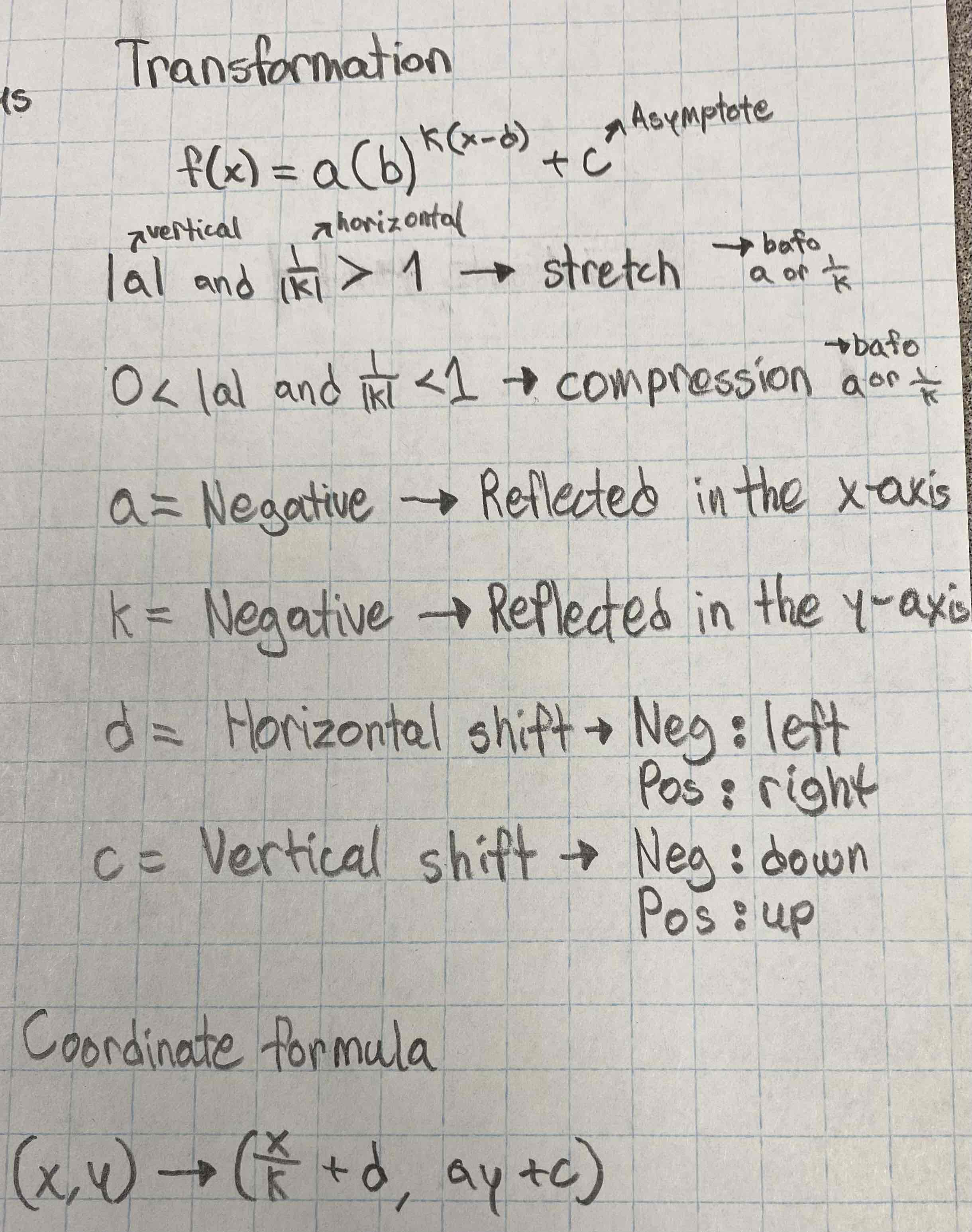
Increasing base exponential function that we use

Decreasing base exponential function that we use

How to solve exponential equations
Rewrite both sides with the same base (by changing the larger numbers exponent)
Set the exponents equal to each other
Solve for the variable
Solving exponential equations using logs
Do the log of the number without the exponent divided by the log of the number with the exponent
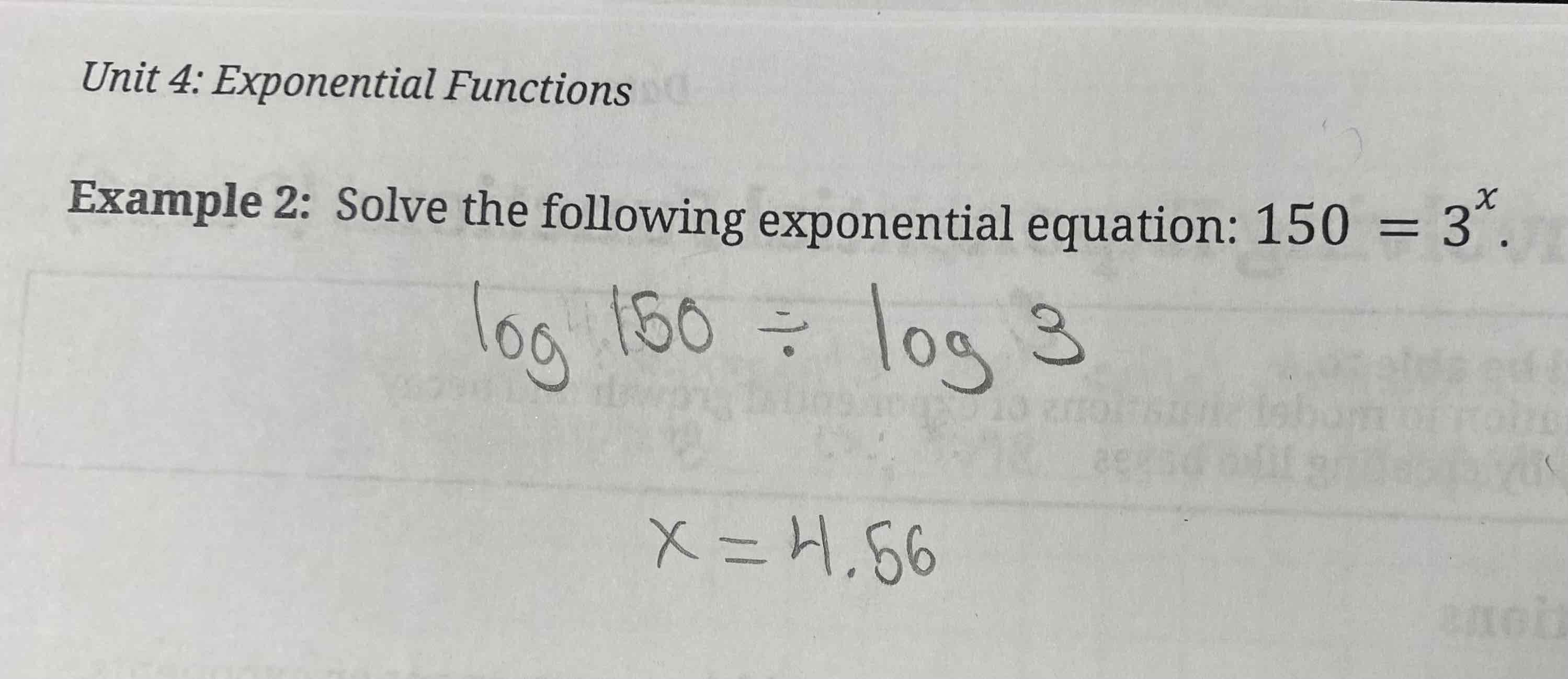
How to model with exponential equations
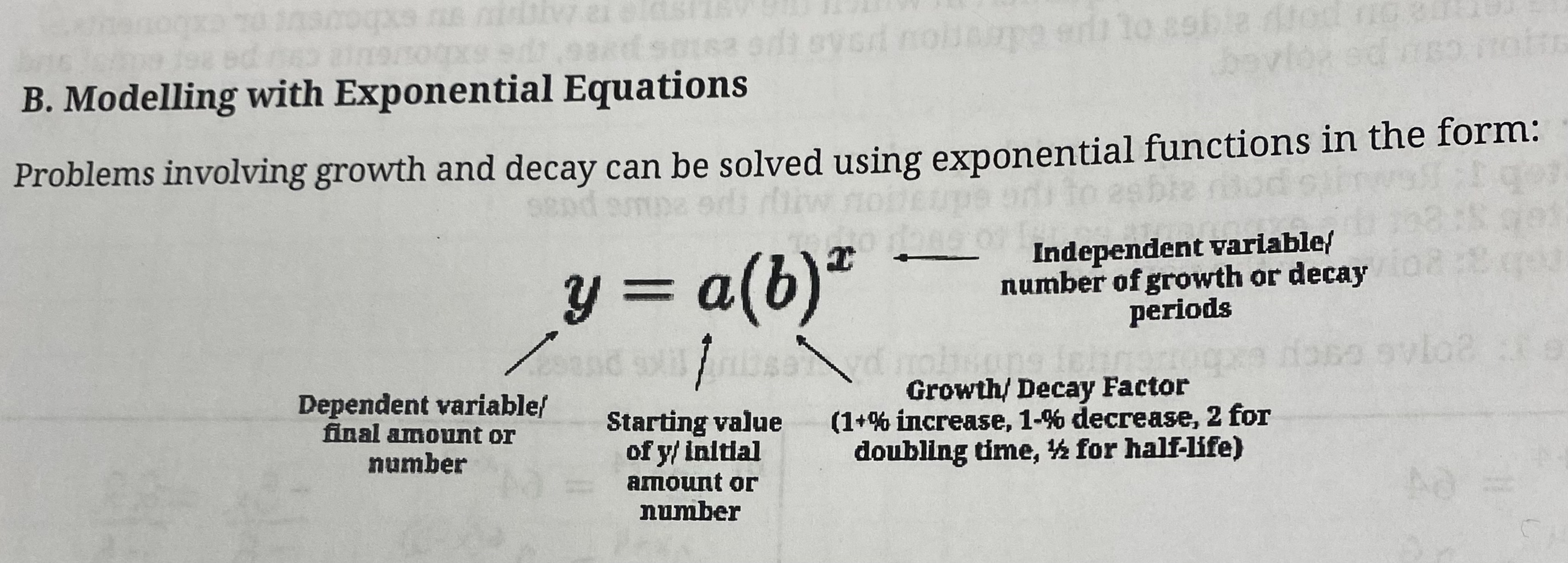
Unit 5
Trigonometry
Trigonometry of Acute Angles (review)
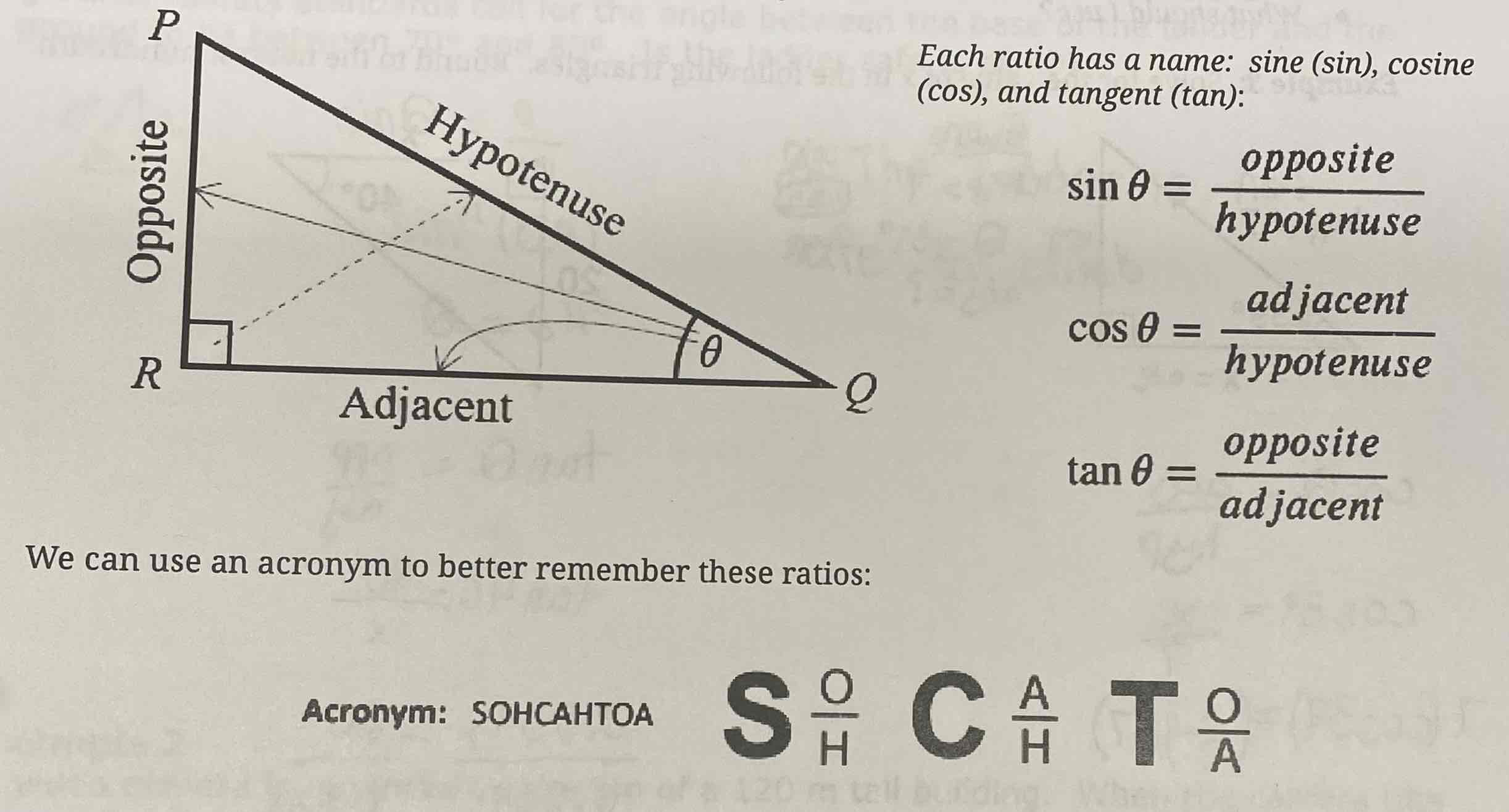
Angle of depression vs elevation
Depression is the line of sight when you are looking down
Elevation is the line of sight when you are looking up
Secondary Trigonometric Ratios

Angles in Standard Position (What is the initial arm, termial arm, principal angle, related acute angle, vertex, 4 quadrants)
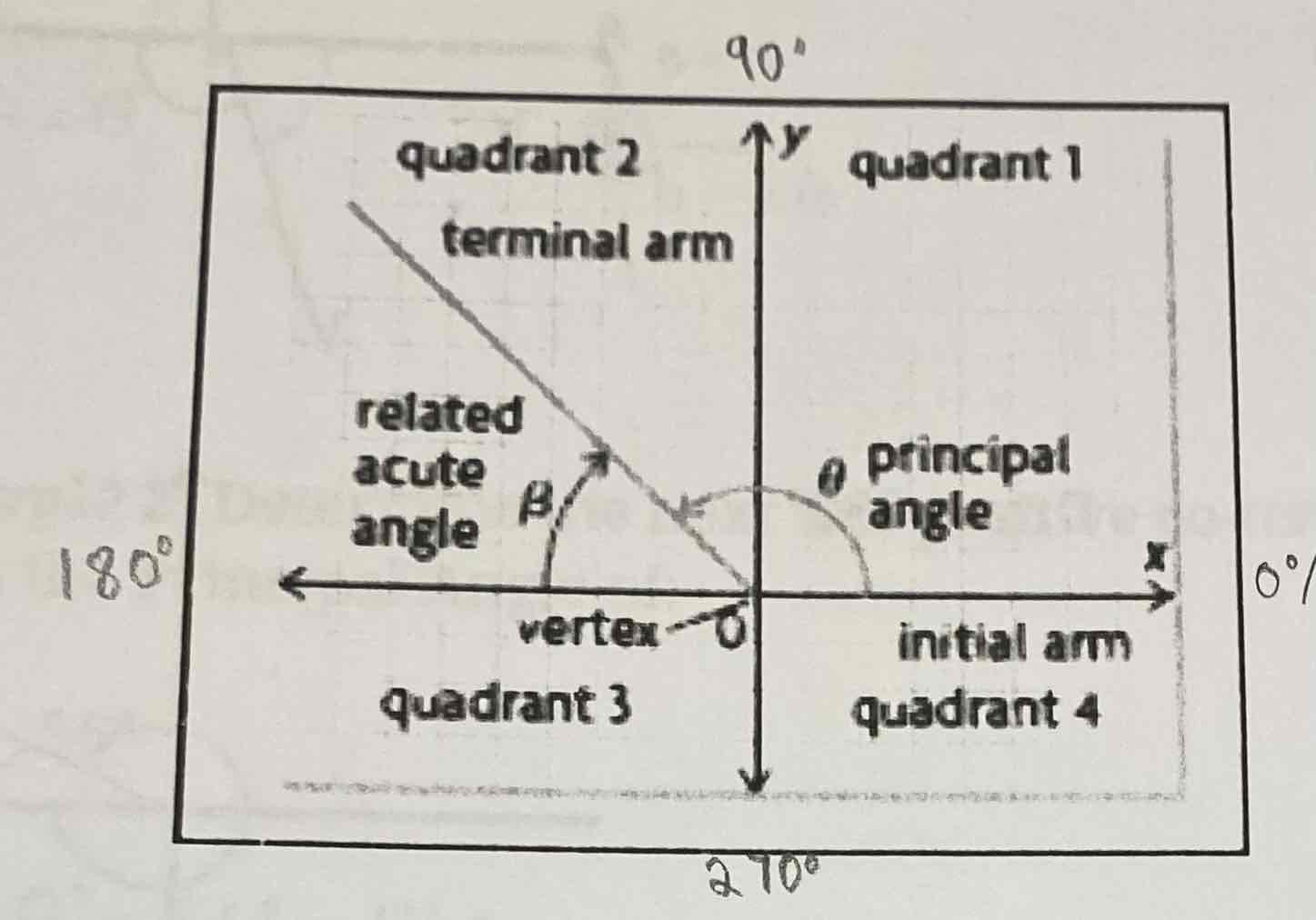
Positive vs Negative Angle
A positive angle goes up from the initial arm
A negative angle goes down from the initial arm
CAST rule
Way to remember which trig ratios are positive in each quadrant
COSINE-ALL-SINE-TANGENT

Sine Law
*Capital letters are angles lowercase are side lengths
You need an angle and its opposite side length to use sine law
If you are looking for an angle use the formula with angles on top
If you are looking for a side length use the formula with the side lengths on top
Cosine Law
*Capital letters are angles lowercase are side lengths
Use cosine law if you have 2 sides and an angle or 3 sides
Ambiguous Case
When using sine law you can get 2 different angles (θ and 180° - θ)
So when using sine law it can be used to find another angle on the same line
Trig Identities
Prove that the left side is equal to the right side
Change everything to sin0 and cos0
If there are fractions being added or subtracted find a common denominator and combine the fractions
Use difference of squares
Use the power rule
Unit 6 Sinusoidal Functions
Period
The length of one cycle (A cycle is one complete pattern in the graph)
Equation of the axis of the curve
The horizontal line that cuts the graph in half.
*Remember to use y = when writing it cause its an equation
y = (max + min) / 2
Amplitude
The distance from the axis of the curve to the max or min of the graph
y = (max - min) / 2
Graphing Sine Function
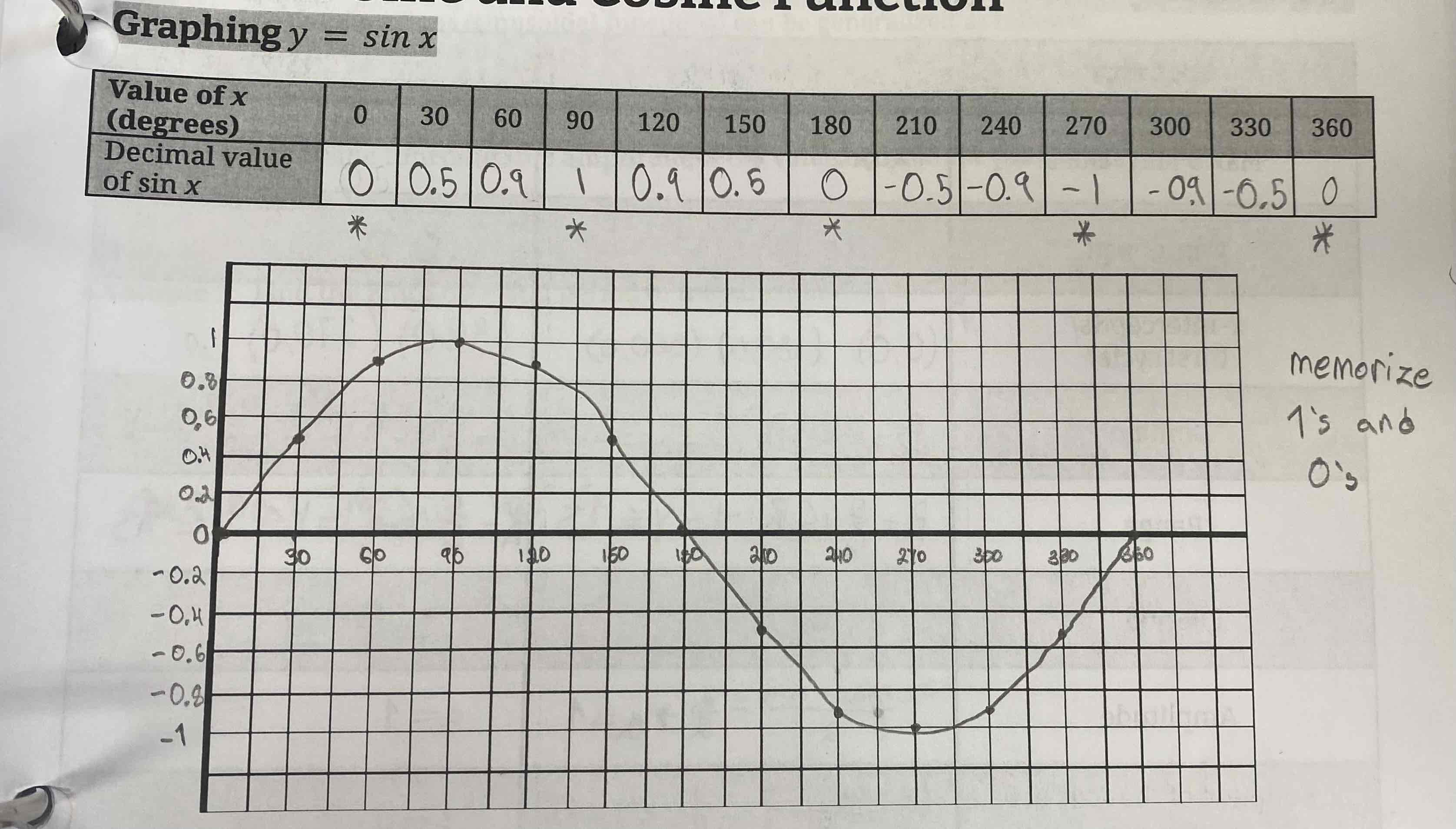
Graphing Cosine Function
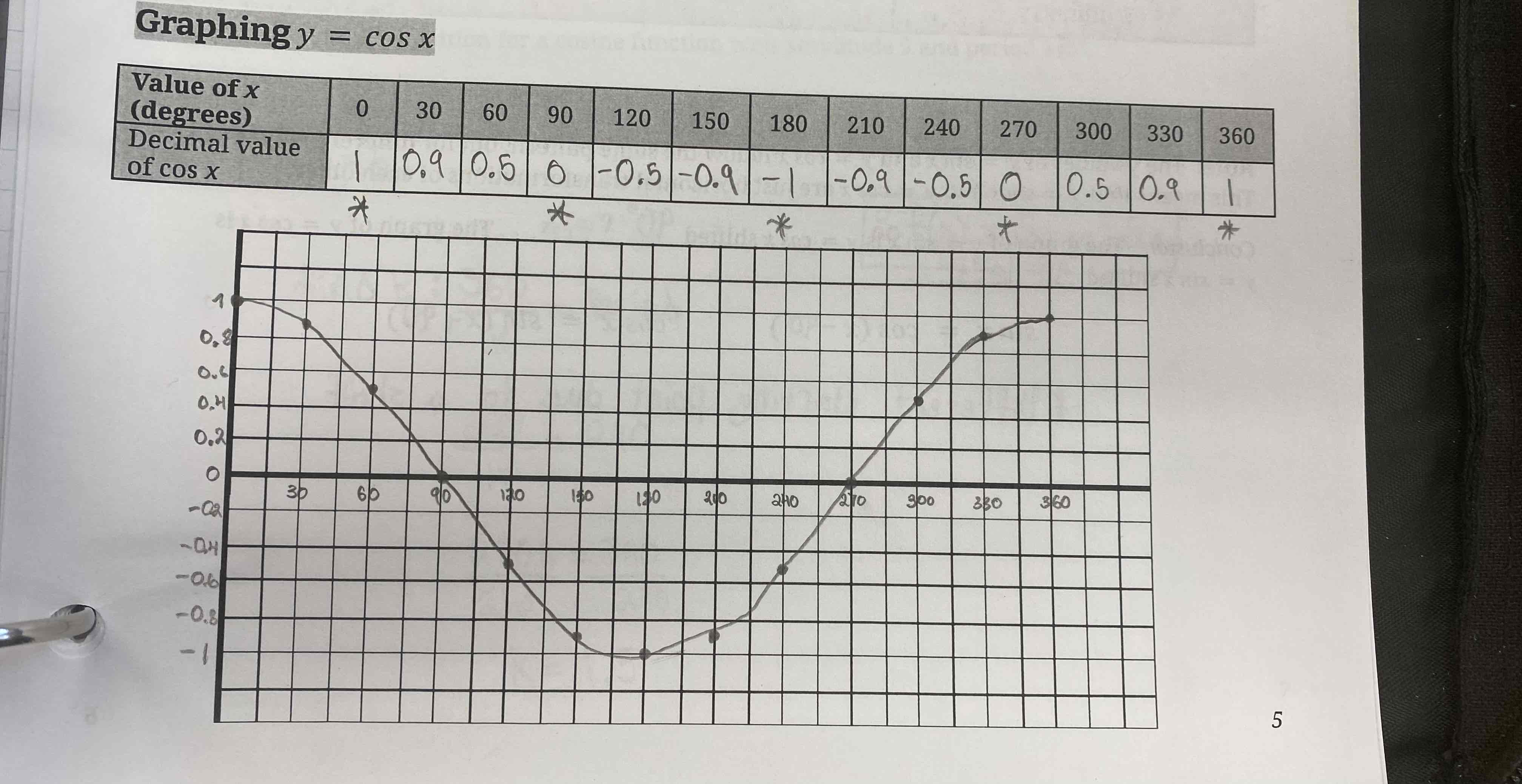
Properties of sine and cosine functions

What are the meaning of the “a” and “k” values of sinusoidal functions
f(x) = a sin k(x)
a: amplitude
k: period: 360/k
Transforming Sinusoidal Functions
y = a sin [k(x - d)] + c
| a | is the amplitude (If negative then reflection in the x-axis)
360/ |k| is the period (If negative then reflection in the y-axis)
d is horizontal shift
c is vertical shift
When doing them all in one first do amplitude and period, then reflections, then shifts
Sequence
A list of numbers arranged in a specific order. They may be finite (end at a certain term value) or infinite (continues to infinity) and denoted by three dots at the end of the list.
Term
Each element of a sequence is called a term. The first term is referred to as t1, and the second term is t2 and so on. The nth term is referred to as tn.
Arithmetic sequence
A sequence that has the same common difference between any pair of consecutive terms. A common difference is obtained by subtracting a term from the previous term. If this value is constant for all terms in the sequence then the sequence is arithmetic. A common difference is denoted by d.
General Term
The general term is a formula to give any term in a sequence just by plugging in n
How to determine a and d/r values from 2 term numbers and their values in a sequence
Make an equation using the arithmetic/geometric formula and leave the variables a and d/r
Use elimination to subtract or divide out (depending if it is arithmetic or geometric) one of the variables from the equation
Solve for the leftover variable
Plug in the solved variable into one of the original equations to solve for the other one
Geometric Sequence
Each term is multiplied by the same value each time. You can find the common ratio by dividing any term by the preceding term.
How to determine the number of terms in a sequence given the first 3 terms and last term
Plug in all the values in to the arithmetic or geometric equation and solve for n
If its geometric you will have to get a common base using log on calculator
Recursion Formula
Must have a t1 =
The equation must use tn-1
Series
the sum of the terms of a sequence. The sum of the first n terms of a sequence is Sn where Sn = all of the tn added together.